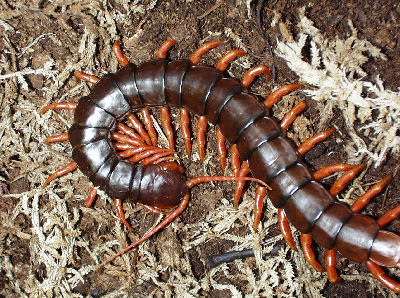Centipedes and Millipedes are weird, intriguing critters with legs… lots of legs!
Centipedes and Millipedes are many legged invertebrates, and some have hundreds of legs. They are both Myriapods. Myriapoda is a subphylum of arthropods consisting of about 13,000 species. Arthropods are invertebrate animals that have an exoskeleton (external skeleton), a segmented body, and jointed appendages. The term myriapoda is compound word derived from the greek term “murias” which means ” ten thousand” and the latin term “poda” which means “foot”.
As Myriapods, there are similarities found in both. They both have elongated bodies that are segmented. They have one pair of antennae, and like the name myriapod suggests, many legs. However none of these have ten thousand appendages, they vary from from fewer than ten to nearly 200 pairs of legs. They are both terrestrial, meaning they are land invertebrates. Most live in humid environments and are found in soils, leaf litter, or under stones and wood. Most species also have repugnatorial glands. These are specialized glands that secrete a foul-tasting compound, like hydrogen cyanide, to help provide defense.
The difference between a centipede and millipede can be seen in body shape and appendages. Centipedes have a more flattened body, while millipedes are more cylindrical. Centipedes have one pair of legs attached to each body segment, where the millepedes have two. Also the legs of the centipede are attached to the side of the body segments, rather than near the ventral midline. Centipedes are unique in that they have a pair of venom claws, called “forcipules”, formed from a modified first appendage. Millipedes have no legs on the first segment behind the head. Centipedes are also carnivores and can move quite fast. Millipedes on the other hand, are mostly slow moving detritivores that feed on decaying leaves and other dead plant matter.
Millipedes are a good first choice arthropod pet!
Millipedes can be handled even by young children, with supervision. They’re fairly low maintenance pets and being plant matter eaters, they are easy and inexpensive to feed. Centipedes on the other hand, are not a good first choice. They are visual pets, the centipede bite is painful and hazardous to humans. They are not to be handled, rather they are enjoyed for their interesting appearance and behaviors.
Centipedes are not a good beginner arthropod pet!
Centipedes are unlike most invertebrate pets being kept in captivity. Receiving a bite from some species can be hazardous to humans and is painful. A centipede bite is unlikely to be fatal to an adult but it can be dangerous to children or those allergic to bee stings, and could induce anaphylactic shock in such people. They are similar to mildly venomous snakes. They should be kept similarly to venomous snakes with a secure enclosure system. Once they are established in a secure enclosure and once some experience is gained in their care and daily husbandry, centipedes can provide hours of fascination.
The list of myriapods below has guides for different types of centipedes and millipedes. Each care guide provides facts and information about them, and about keeping them as pets. Care includes diet, foods and feeding, housing needs and tips for handling.
For information on keeping myriapods as pets, see:
Centipede and Millipede Care


